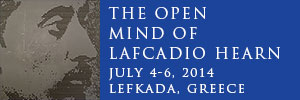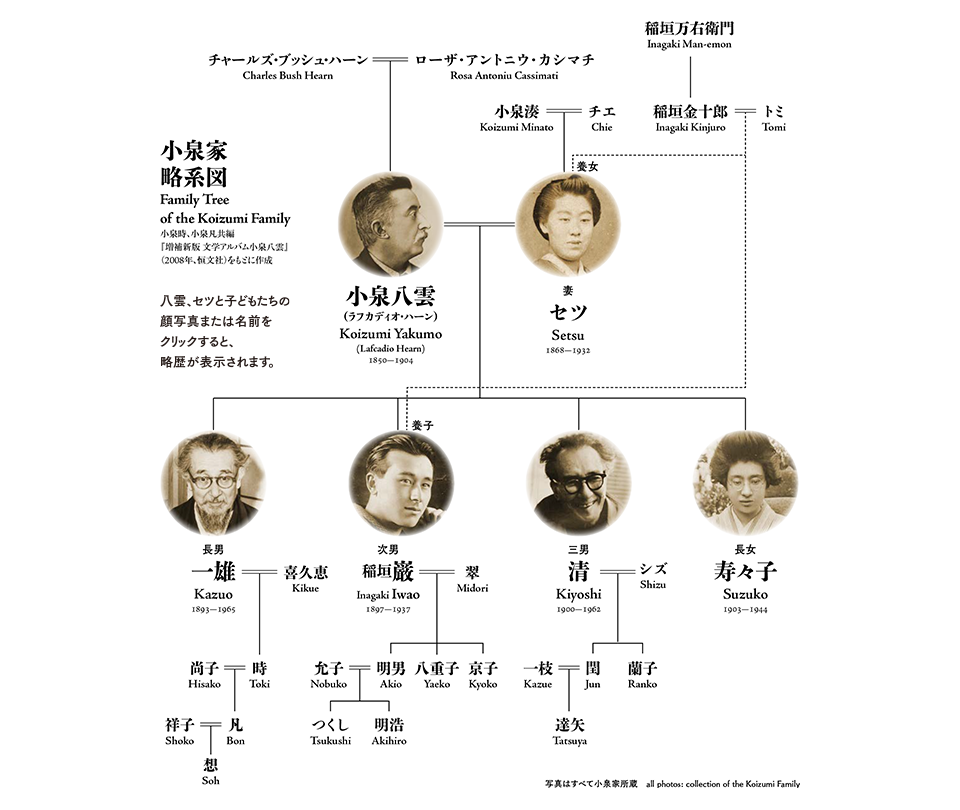Outline
Born in Greece and raised in Ireland, Lafcadio Hearn travelled halfway around the world before arriving in Japan, where he settled and started a family. He died, as a Japanese national, at the age of fifty-four. Using stories passed down through the generations, this exhibition offers glimpses into Hearn’s life and the lives of his beloved wife and children.
Lafcadio Hearn passed away quietly on 26 September, 1904. He was fifty-four. He died at his home in Nishi-Okubo, Tokyo, where he was being cared for by his family.
....and said quietly, “Mamma-san, the sickness of the other day has come back again.” I went with him. For while he walked around the room with his hands on his breast. I advised him to lie quietly on the bed, and he died so. Very soon after that he was no longer of this world. He died without any pain, having little smile around his mouth. It could not be helped, if it was the order of Heaven. I wish that I could have taken care of him, and given all my strength in nursing him. This was too easy a death for me. (Reminiscences of Lafcadio Hearn by Setsuko Koizumi)
Lafcadio Hearn’s parents divorced when he was a child. He was raised by a great-aunt in Ireland, who later suffered financial difficulties. He immigrated to the USA, where his life was lonely and often solitary. Beset by misfortunes in his youth, Hearn longed for his Greek mother, Rosa, and yearned for a warm, loving family. After arriving in Japan in 1890, he found employment as an English teacher at a school in Matsue. Here, he met Setsu, whom he married, and for the first time in his life, he had a family of his own.
Except for a short period of time while living in Cincinnati, Hearn had been alone. However, upon marrying Setsu, he became the head of a large family, which included Setsu’s real mother, and her adoptive parents. Before long, his first son Kazuo was born, followed by two more sons and a daughter.
Hearn, the family man.
Kazuo Koizumi says in the introduction to Father and I by Kazuo Koizumi).: “My father died when I was ten. To me, as a young boy, he was a father, a family man. I didn’t know the man who gave solemn lectures or wrote difficult works.” To his children, Hearn was at times a strict educator and disciplinarian. However, he was also a kind and loving father, and was often humorous, and displayed a childlike heart.
This exhibition commemorates the 110th anniversary of Hearn’s death, and aims, through memoirs written by his wife and children, to uncover another little-known side to this man. At the time of Hearn’s death, his eldest son, Kazuo, was ten, his other sons Iwao and Kiyoshi were six and four, and his daughter Suzuko was just one year old. From the family memoirs and the many photographs provided by the Koizumi family, this exhibition offers glimpses into their family life, and shows the fondness the children felt towards their father. Setsu and Hearn called each other Papa san and Mama san, as a mark of respect and affection, and they communicated in a unique form of Japanese which they called “Hearn’s language”.
This exhibition has been structured with reference to the following works written by members of Hearn’s family: Reminiscences of Lafcadio Hearn by Setsuko Koizumi (1918, Houghton Mifflin Co.), Father and I by Kazuo Koizumi (1935 Houghton Mifflin Co.), Father Koizumi Yakumo by Kazuo Koizumi (1950, Koyama Shoten), RE-ECHO by Kazuo Koizumi, Edited by Nancy J. Fellers (1957 Caxton Printers. Ltd.) These works offer insight into Hearn’s writing habits, and a daily life overflowing with human warmth. Based on the concept of “family”, this exhibition aims to show Hearn in a new light. It will also consider the lives of Hearn’s children after his death.
Hearn’s son Kazuo says, “Born into this world, he first learned Greek, was brought up to speak English, was taught French, Latin, and Spanish; this Hearn on his deathbed uttered, ‘ah, byoki no tame’ (Ah, on account of sickness) regretfully, resignedly, left his final utterance in Japanese—died as a Japanese. Thus did Hearn pass away. (Father and I)
Hearn, a British national, became a naturalized Japanese citizen for his wife and children, and died as Koizumi Yakumo, a Japanese national. Through this exhibition, it is hoped that visitors will be able to see the man behind the writer.
In this year, the 110th anniversary of Hearn’s death, an international symposium and commemorative event will be held in July in Lefkada, Greece, the place of his birth. This event will attempt an interpretation of Hearn’s “Open Mind” and explore ways to connect Hearn’s legacy with the future. Since 2009, Hearn has been reevaluated from a range of perspectives, and attempts are being made to apply these newfound ideas and values in a practical way. This is changing people’s awareness of Hearn, not only in Japan, but also across the world. It is hoped that this exhibition “Hearn and Family” will bring a fresh perspective to Lafcadio Hearn.
organizers: NPO Matsue Tourism / Matsue City Municipaly
coorination: The Koizumi Family / The Inagaki Family
superviser: Koizumi Bon
coordinator: Koizumi Shoko
designer: Ishikawa Kiyoharu



